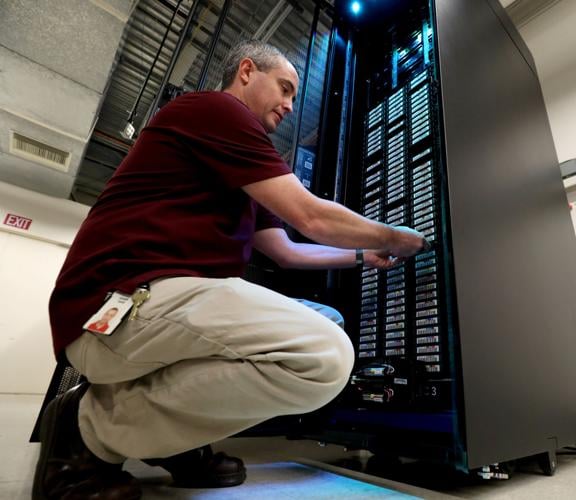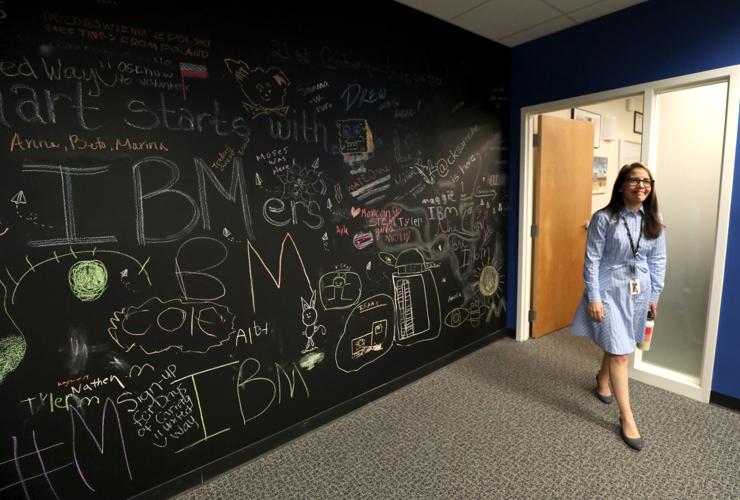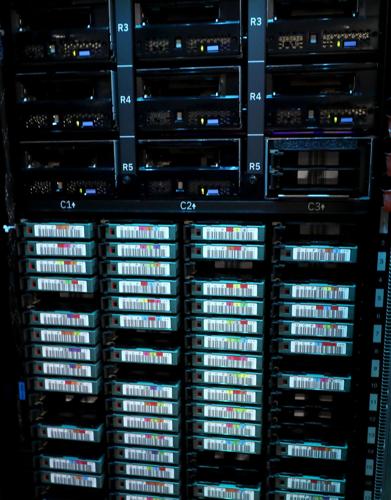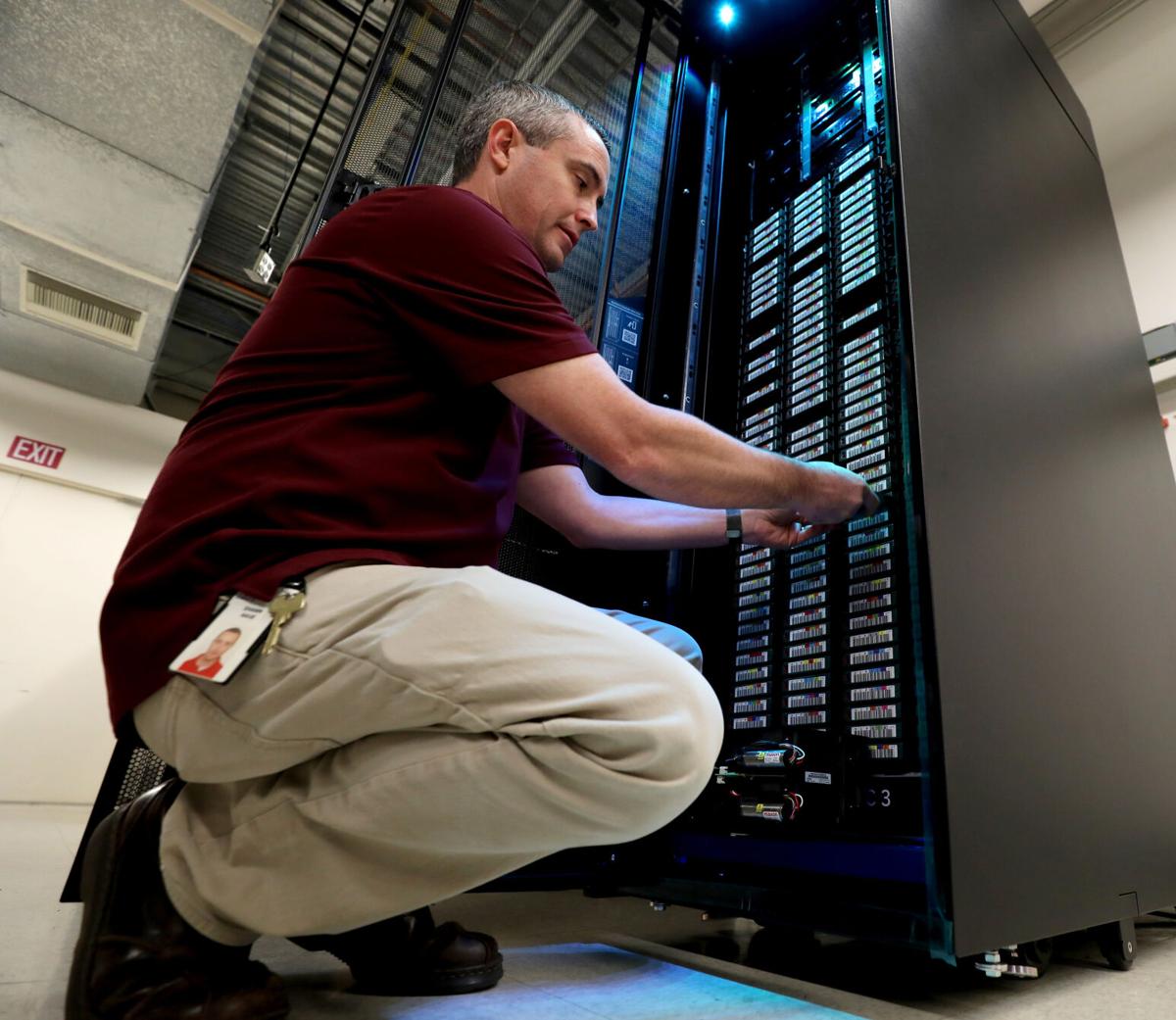More than 40 years after arriving in Tucson, computing giant IBM is still churning out innovations in data-storage technology from its labs at the University of Arizona Science and Technology Park.
And Big Blue’s Tucson engineers are also keeping its customers’ data safe in the ever-changing, increasingly hazardous world of cyberspace.
One example is the recently rolled out IBM Diamondback Tape Library, a high-capacity, archival tape-storage system designed for organizations needing to securely store hundreds of petabytes of data — each one equal to more than 220,000 DVD movies.
IBM says its Diamondback’s main benefits include low power usage, high-capacity storage at about a quarter of the cost of spinning hard-disk drives.
But its timely selling point involves an inherent ability of removable tape media: to disconnect data from the internet and private networks vulnerable to online attacks.
The ability to physically “air-gap” data can help protect big users against ransomware — when a hacker blocks access to networks or data and demands a ransom to release it — and other cyber threats, IBM says.
Calline Sanchez, IBM vice president in charge of the Tucson storage-system development, said the company worked with some of its “hyperscale” customers — companies like cloud-computing services that store tremendous amounts of data — to help design the Diamondback.
“We decided to really work with our partners, our clients and users and discuss what we want to do from an air-gap perspective, or cyber resiliency perspective,” said Sanchez, a UA alumna who also is IBM’s state executive for Arizona and her native New Mexico.
With data breaches and ransomware attacks now a constant threat, IBM says it’s seeing its big-data customers increasingly turn to tape for data resilience.
“From an air-gap perspective it somewhat detaches itself from the actual base infrastructure of a data center, so it’s self-sustaining,” said Sanchez. “It’s truly this idea of sustainable block storage of data, where it’s not easily accessible at all, from the outside world.”

Calline Sanchez, IBM Vice President and Tucson site leader, says the company’s latest tape storage system can protect data from hackers by removing it from any network.
Need for tape
While tape data storage was seen as a fading technology years ago as faster hard-disk drive and solid-state “flash” storage advanced, sales of tape have surged amid the seemingly endless growth in data.
Sales of tape media for so-called “Linear Tape Open“ or LTO Ultrium — an industry-standard tape technology provided by a consortium comprised of IBM, Hewlett Packard and Quantum Corp., rose a record 40% in 2021 to 148 exabytes of capacity (an exabyte is equal to about 1000 petabytes, or a billion gigabytes), according to the Silicon Valley-based LTO Program.
LTO tape is arguably the lowest-cost, simplest practice to recover from ransomware attacks, said Phil Goodwin, research vice president at the IT research firm IDC.
“Ransomware and malware are threats that will not go away,” Goodwin said as part of the LTO Program’s sales report. “Magnetic tape is an established, understood and proven technology that can be an invaluable tool for defeating ransomware.”

The IBM Diamondback Tape Library, a high-density archival storage system with removable tape cartridges that are transported and accessed as needed by a robotic assembly.
Sanchez credits tape’s resurgence to its sustainability and energy efficiency, as well as its ability to air-gap against cyber threats.
“It’s lower cost than the other storage media types like diskettes or hard disk drives, as well as flash drives,” she said. “And that’s part of the reason why now tape is feeding primarily the back-end infrastructure of cloud environments.”
Tech park crucible
Like most of IBM’s data storage systems developed over the past four decades, the Diamondback was developed at the company’s multi-building campus at the UA Tech Park on South Rita Road.
IBM built what is now the UA Tech Park in the early 1980s to house storage systems development and manufacturing facilities that employed some 5,000 people in an initial 10 buildings comprising more than 1.3 million square feet.
As part of a major restructuring in 1988, IBM moved the manufacturing part of the operation and nearly 3,000 jobs to San Jose, California, but kept its storage research and development units going.
The company sold its sprawling campus on South Rita Road to the UA in 1994, but stayed on as a tenant.
Today, its storage development labs are still going strong, with about 1,000 workers spread across more than 600,000 square feet in four buildings.
IBM’s local operation — which last week was awarded the Large Company Innovator of the Year at the Governor’s Celebration of Innovation Awards— generates more than 400 patents annually, Sanchez said.

IBM has about 1,000 workers spread across more than 600,000 square feet in four buildings at the UA Tech Park.
Testing tape
At the Tech Park, IBM develops and tests a range of storage systems and media, including disk, tape and flash systems.
Inside the reliability testing lab at the Tech Park’s 9032 Building, IBM engineers have been conducting final testing on brand-new Diamondback Tape Library systems, which are about the size of a narrow refrigerator, with rows of shelving holding palm-sized tape cartridges.
With a constant hum of clicks and whirs, a robotic shuttle moves back and forth inside the Diamondback cabinet, plucking and mounting barcoded tape cartridges according to a preset program.
Each cartridge can hold 18 terabytes, or 1,000 gigabytes of data, and a full Diamondback packs 1,548 LTO cartridges, for total storage of 27 petabytes that can be up and running within 30 minutes of delivery, said Shawn Nave, an IBM mechanical engineer who helped develop the Diamondback.
A row of Diamondbacks were undergoing testing last week, and like all the products tested in the lab they will be put through their paces.
“As part of this testing, we run it until the wheels fall off, and see what happens,” said Nave, one of many UA alumni at IBM’s local operation.
A nearby building houses labs that subject the IBM hardware to extremes of temperatures and other environmental challenges, Sanchez noted.
As the world continues to generate more and more data, the engineers and scientists at the Tucson-area IBM site will continue to innovate to keep up, said Sanchez, whose 22 years with IBM include a year-long stint in 2008 working for Nick Donofrio, a well-known tech figure who led IBM’s technology and innovation strategies for a decade before retiring in 2008 after 44 years with Big Blue.
Behind the curtain
Sanchez likens IBM’s storage systems and services to the Wizard of Oz hiding behind his curtain, remaining unseen while making everything happen.
“That is from a back-end infrastructure perspective what IBM provides — we make it easier for these enterprises, because it’s totally easy to consume large amounts of data on these significant systems,” she said.
“Where like right now in our lab, we’re not just talking about petabytes. We’re talking about how to serve exabytes (each 1,000 petabytes), as well as zettabytes (1,000 exabytes).”

Sanchez
“Because we just know in a short period of time, we’re going to have research institutions coming to us and saying, ‘Hey, Calline, we’ve outgrown our two petabytes of research data we have in all U.S. research, universities, we need you to start building based on exabytes or possibly zettabytes.’ And to me, that’s crazy.”
IBM engineers are working to increase data storage and efficiency using artificial intelligence, which essentially programs machines to “think” like humans, but Sanchez doesn’t like that term.
“I like more ‘augmented intelligence,’ for the betterment of humankind, and what is great about working in data storage is you continue to think in that direction,” she said. “Because you’ve got to figure out the physics of how to store an immense amount of data that is being created by people on this Earth and with the devices like this.”
The CHSF Hospital Centre in Corbeil-Essonnes, southeast of the French capital, has been the victim of a computer attack that began late Saturday night.









